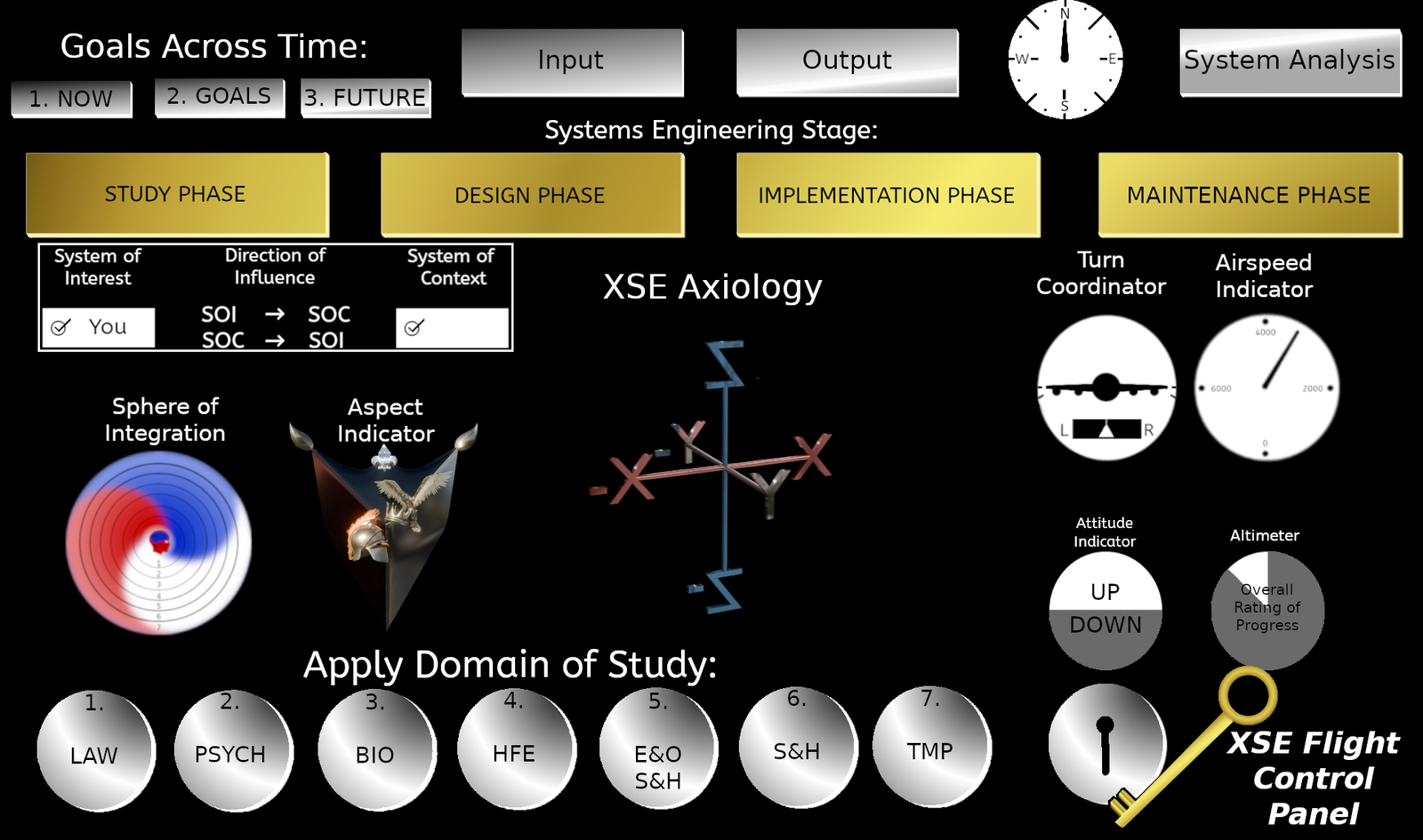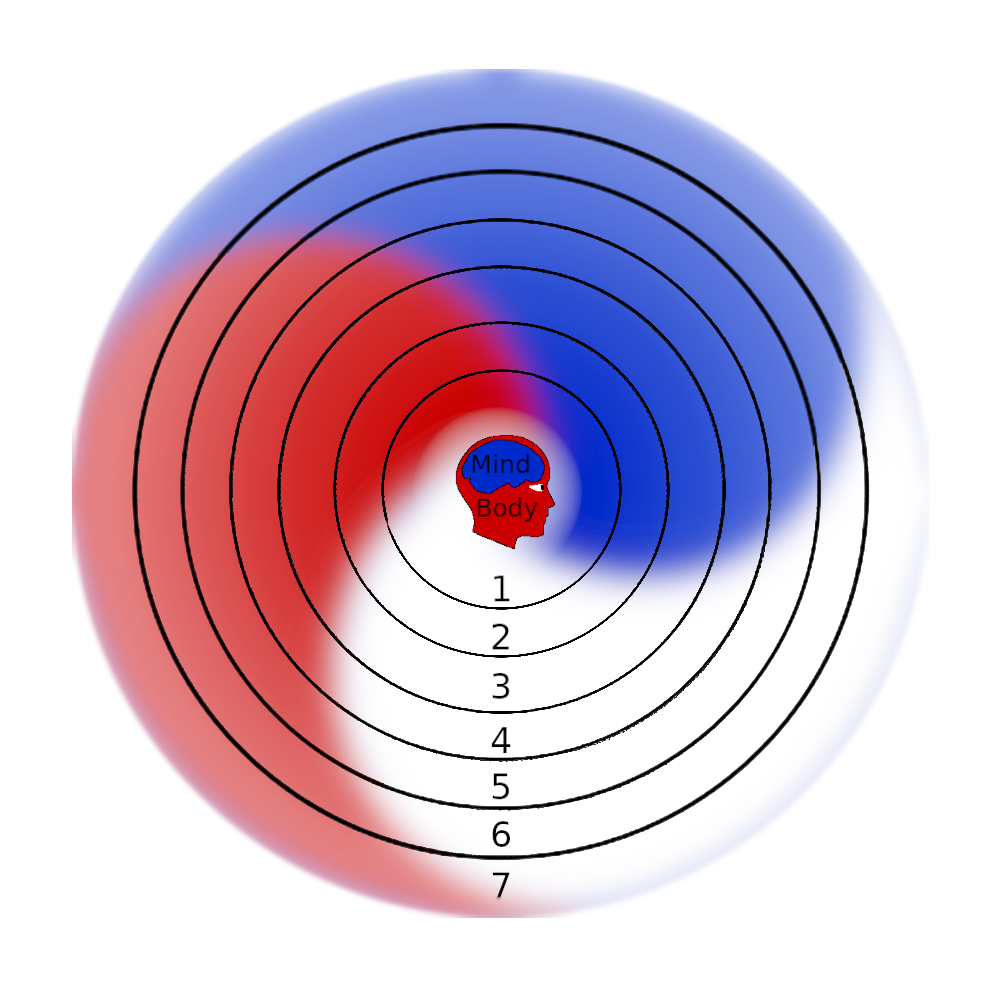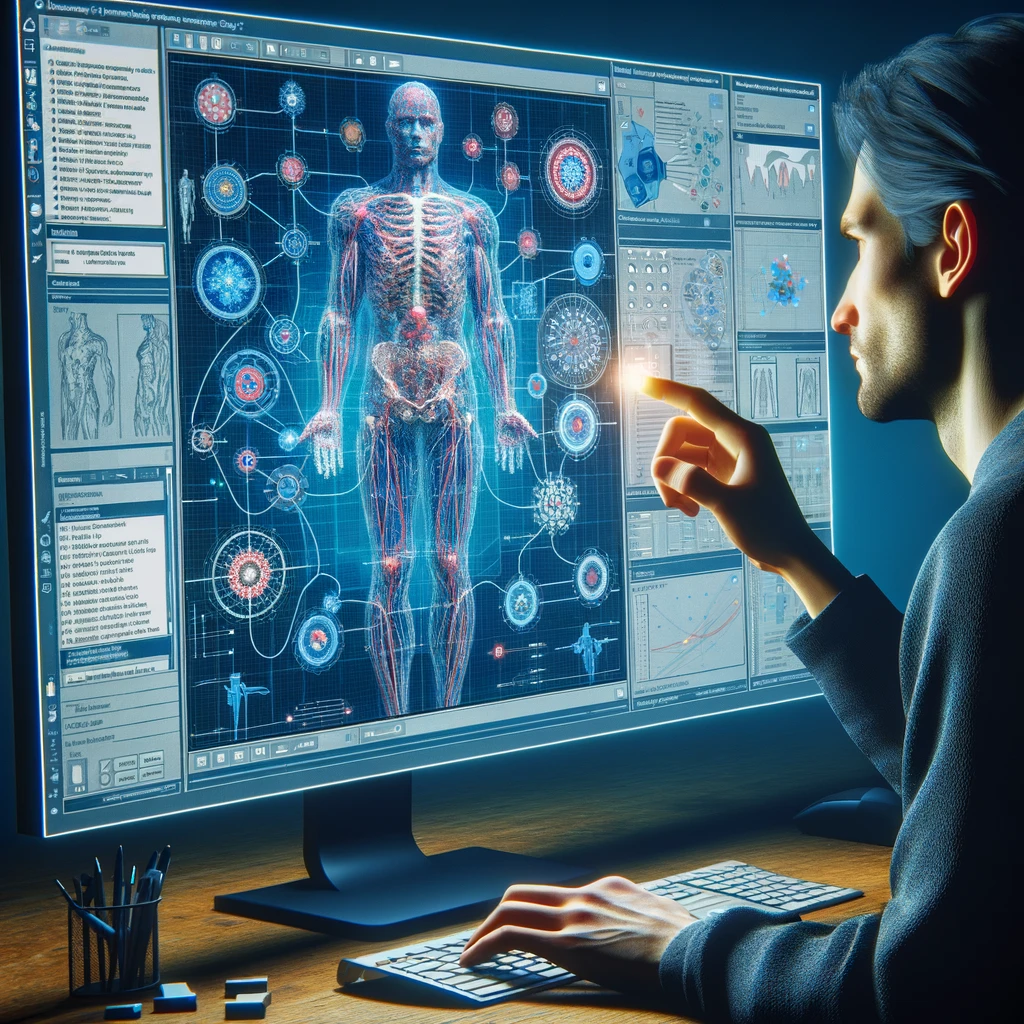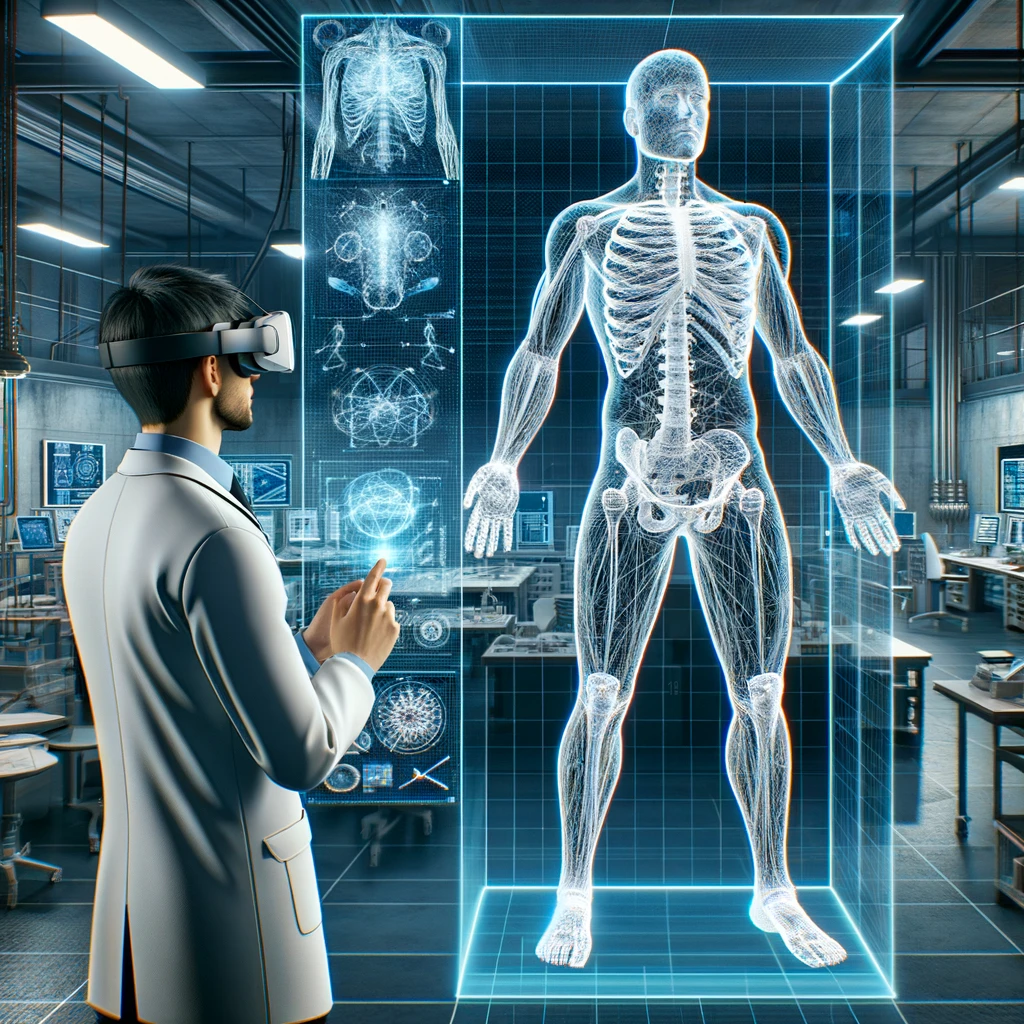XSE Flight: Designing Advancement

The human being is a complex system and now with life being more complicated than ever before, it can be difficult to sort through and understand all that is affecting our daily lives. But endless scientific discoveries have been made and multitudes of studies have been done, resulting in a wealth of information. Now with the analytical power of AI, this information can strategically be used to provide insight to help navigate smoothly in a world overwhelmed by choices, confusion, and distractions. XSE initiates critical and creative thinking skills for masterly analysis to arrive at your own decisions of optimal choices, while opening your eyes to new horizons and possibilities, maximizing your systems potential, while additionally presenting surprising research and facts on the operation of your system to assist in advancement.
Leveraging AI for Systems Engineering

AI can facilitate your ability to be your own pilot – of your own system, whether that be a new system that you are engineering, or just taking the reins in the life of your own system (you). XSE Flight is being designed to present to you tools using XSE’s strategies and methods. Here’s how AI can help guide a “Pilot” systems engineer through the use of a systems engineering program:
Requirement Analysis: AI can assist systems engineers in analyzing and prioritizing requirements by automatically extracting, categorizing, and organizing information from various sources such as documents, specifications, and stakeholder inputs. Natural language processing (NLP) techniques can be used to understand and interpret textual requirements, identify dependencies, and detect inconsistencies or ambiguities.
Design Exploration: AI algorithms can help systems engineers explore and evaluate design alternatives by generating and analyzing different configurations, architectures, or solutions based on specified constraints, objectives, and performance criteria. Machine learning (ML) models can be trained on historical data to predict the potential impact of design choices on system behavior, performance, cost, and reliability.
Simulation and Modeling: AI-driven simulation tools can assist systems engineers in simulating and modeling complex systems, subsystems, or processes to assess their behavior, performance, and interactions under different scenarios or conditions. AI techniques such as reinforcement learning (RL) can be used to optimize system parameters, control policies, or decision-making strategies to achieve desired outcomes.
Decision Support: AI-powered decision support systems can provide recommendations, insights, or alerts to assist systems engineers in making informed decisions throughout the systems engineering lifecycle. AI algorithms can analyze data, identify patterns, and generate actionable insights to support trade-off analysis, risk assessment, and decision-making under uncertainty.
Error Detection and Correction: AI algorithms can help systems engineers detect and correct errors, anomalies, or inconsistencies in system models, requirements, or designs. AI-driven quality assurance tools can analyze artifacts, identify deviations from standards or best practices, and suggest corrective actions to improve the integrity and reliability of the system.
Knowledge Management: AI-based knowledge management systems can capture, organize, and leverage tacit and explicit knowledge from past projects, lessons learned, and domain experts to support systems engineering activities. AI techniques such as knowledge representation, semantic reasoning, and knowledge discovery can help systems engineers access relevant information, best practices, and expertise to enhance decision-making and problem-solving.
Collaborative Tools: AI-driven collaborative tools can facilitate communication, coordination, and collaboration among multidisciplinary teams involved in systems engineering projects. AI algorithms can analyze communication patterns, identify knowledge gaps, and suggest interventions to improve team dynamics, productivity, and effectiveness.
Overall, AI can serve as a valuable co-pilot for systems engineers, providing assistance, automation, and augmentation across various phases of the systems engineering lifecycle. By harnessing the power of AI technologies, systems engineers can enhance their capabilities, streamline their workflows, and deliver more effective and efficient solutions to complex engineering challenges.
What can a "Pilot" Systems Engineer gain from AI?

If trained properly, an AI co-pilot with its diverse capabilities would be an incomparable and irreplaceable benefit to a systems engineer, particularly in scenarios where the engineer is the system of interest. Here’s how:
-
Personalized Assistance: The AI co-pilot can provide personalized assistance tailored to the specific needs, preferences, and objectives of the systems engineer. By analyzing historical data, user interactions, and contextual information, the AI can offer recommendations, insights, and solutions that are highly relevant and actionable for the engineer’s unique circumstances.
-
Optimized Decision-Making: The AI co-pilot can enhance the engineer’s decision-making process by analyzing vast amounts of data, identifying patterns, and simulating potential outcomes. By leveraging machine learning algorithms and predictive analytics, the AI can help the engineer anticipate risks, evaluate trade-offs, and optimize decisions to achieve desired outcomes more effectively and efficiently.
-
Continuous Learning and Improvement: The AI co-pilot continuously learns and adapts over time based on feedback, experience, and new data. As the engineer interacts with the AI and provides input, the system becomes increasingly proficient at understanding the engineer’s preferences, anticipating their needs, and delivering relevant assistance. This iterative learning process ensures that the AI co-pilot evolves and improves its performance over time, becoming more valuable and indispensable to the engineer.
-
Comprehensive Support Across Lifecycle: The AI co-pilot provides comprehensive support to the engineer across the entire systems engineering lifecycle, from requirements analysis and design exploration to simulation, modeling, and decision support. By integrating seamlessly into the engineer’s workflow and providing assistance at every stage of the process, the AI enhances productivity, efficiency, and effectiveness, allowing the engineer to focus on higher-level tasks and strategic priorities.
-
Augmented Creativity and Innovation: The AI co-pilot augments the engineer’s creativity and innovation by generating novel ideas, exploring alternative solutions, and challenging conventional thinking. By leveraging generative AI techniques such as deep learning and evolutionary algorithms, the AI can inspire the engineer with new perspectives, insights, and possibilities that may not have been considered otherwise, leading to breakthrough innovations and transformative solutions.
-
Empowerment and Empathy: The AI co-pilot empowers the engineer by providing tools, resources, and support to overcome challenges, solve problems, and achieve goals. Through natural language processing and conversational interfaces, the AI fosters a sense of empathy and collaboration, engaging in meaningful interactions with the engineer and offering guidance, encouragement, and reassurance when needed.
-
Symbiotic Relationship: Ultimately, the AI co-pilot forms a symbiotic relationship with the systems engineer, complementing their skills, expertise, and intuition with advanced computational capabilities, data-driven insights, and algorithmic intelligence. Together, the engineer and AI co-pilot form a dynamic partnership that leverages the strengths of both human cognition and artificial intelligence to tackle complex engineering problems, drive innovation, and create value in ways that neither could achieve alone.
In summary, a well-trained AI co-pilot would be an invaluable asset to a systems engineer, especially in scenarios where the engineer is the system of interest. By providing personalized assistance, optimized decision-making, continuous learning, comprehensive support, augmented creativity, empowerment, and empathy, the AI co-pilot enhances the engineer’s capabilities, effectiveness, and success in navigating complex engineering challenges and achieving their objectives.
Designing the first SE software program with you as the Primary System of Interest (SOI)

XSE FLIGHT is being designed as a systems engineering software program based on Independent Integration Systems Engineering (XSE). XSE Flight is intended to be available both individually as a Systems Engineering Software Program and also as software that can be integrated with other software programs. Click on the buttons below for an up-close preview of some of the proposed operations of the XSE FLIGHT control panel.
XSE Flight Control Panel

1. Now

What is the current status of your System of Interest (For example, you).
Who are you and where are you at in life?
Y Axis

The actual stage of the system life cycle is plotted on the Y axis (not chronological age). This Axis is shown in red as it relates to the body or physical aspect, and is connected to the 2nd element of Luxxacation "Build Strength." Correlated to the Y Axis is the Y Axiom, which states that after analysis (X Axis) "The application of optimal choices enhances strength." The 2nd Axiom likewise correlates to the Y Axis, and states that "True and optimal strength is founded on integrity."
Z Axis

Sourcing is plotted on the Z Axis. This Axis is shown in white as it relates to the spirtitual aspect, and is connected to the 3rd element of Luxxacation "Rise Above." Correlated to the Z Axis is the Z Axiom, which states that "Seeking authentic and ultimate sources maximizes freedom." The 3rd Axiom likewise correlates to the Z Axis, and states that "True and optimal freedom is founded in integrity."
X Axis

Analysis is plotted on the X axis. This Axis is shown in blue as it relates to the mind or mental aspect, and is connected to the 1st element of Luxxacation "Take Time." Correlated to the X Axis is the X Axiom, which states that "Using critical and creative thinking augments intelligence." The 1st Axiom likewise correlates to the X Axis, and states that "True and optimal intelligence is founded on integrity."
System of Interest

The System of Interest (SOI) is the system that you are wanting to develop, engineer or reverse engineer (study), and in XSE this always defaults to you though it can be used for any SOI.
2. Goals

This is where goals will be made to fulfill the vision, plans or requirements of your SOI. Try different kinds of goal setting techniques and occasionally try applying different of strategies to meet them. Use the XSE Key during crucial moments when faced with sub-optimal decisions contrary to goals set.
3. Future

What is your vision, requirements or plans for where you want your System of Interest to be in the future? At 6 weeks? At 3 months? At 6 months? One Year? 5 years? 10 Years?
Compass

The compass will show points plotted for goals set with different deadlines, and where you are on the path to those goals.
Direction of Influence

The Direction of Influence control is used to change view point or direction of action between the System of Interest (SOI) and the System of Context (SOC). For instance, if you are the SOI and your office is the SOC you can choose to evaluate either the direction of how you influence your office, and then secondly, how your office influences you.
Maintenance Phase

In general, the maintenance period includes operating the System of Interest (consider how different elements affect it's performance) and sustaining the operation (Is it functioning optimally? What could help it function better?), and the support needed (what resources are required to support your SOI? Does your SOI help support others?). This phase ends with deactivation or disposal, which is a must for systems engineers to look ahead to.
Aspect Indicator

The aspect indicator is used to evaluate any System of Interests (SOI)effects on any particular one of the 3 aspects of the human: the body, mind or spirit. For instance, if the SOI is a factory that will operate with both day and night crews, the effects on the spirits of the day crew may have a more normal forecast than the spirits of the night crew, simply due to the fact that the night crew will have to deal with staying awake at times contrary to their natural circadian rhythm, and if the night crew is struggling to keep up good spirits, their production may be less.
Attitude Indicator

The attitude indicator helps keep tabs on the attitude regarding the System of Interest. Do you have a positive attitude in relation to the SOI? A positive attitude is usually directly correlated to gratitude. A positive attitude also helps you advance more efficiently regarding the SOI.
Airspeed Indicator

The Airspeed Indicator shows an evaluation of the speed at which you are advancing relative to the goals you have set for your SOI and the timelines you have laid out for those goals.
System of Context

What larger system are you evaluating your System of Interest in? This is always going to be on a broader plane than your SOI. For instance, if you are your SOI, your System of context may be your family, your office, your community, your country, etc.
Implementation Phase

This generic stage of Systems Engineering would include source selection (what products and resources are you going to use for your SOI?), Development (bring the plans for your SOI to life!), Verification (does the SOI meet the specs of what it should do?), Validation (Does the SOI meet the needs and expectations?), Production and Deployment (including what does your SOI produce and the ripple effects).
Output

The outputs of the system (if the system of interest is yourself) may be anything from physical, social, environmental, etc. Suggested inputs are presented in order to achieve desired outputs. Outputs can refer to various aspects of behavior, function, or outcomes that result from the interactions and processes within the system. These outputs encompass a wide range of phenomena across different levels of organization, from individual physiological processes to interpersonal relationships to societal dynamics.
3. Biology and Applicable Sciences

Biology and applicable sciences is a domain of study of XSE that is applied during the engineering process. How does research from the field of Biology or other applicable sciences apply to your System of Interest? How can any of this scientific information be used to improve your SOI or its operation? Conversely, how does your SOI affect any kind of life on the planet? How does your SOI affect the environment? Should you make any alterations regarding this effect?
Study Phase

This generic stage of Systems Engineering encompasses exploring different ideas leading to inception, including concept realization and the inception of innovative inventions (the power of meditation) and understanding or learning about your system of Interest. This stage includes many other stages of Systems Engineering such as Specs and Requirements and Product Definition Stages.
7. Training, Manpower, & Personnel

Training, Manpower & Personnel (TMP) is a domain of study of XSE that is applied during the engineering process. How does TMP apply to your System of Interest? How can any TMP related research be used to provide insight into your SOI, its operation or its potential? A question to grapple with if you appreciate turbulence: how does your SOI already play into a program of Training, Manpower or Personnel as part of a larger operation already in effect whether inadvertently or possibly even unbeknownst to you? Should you make any alterations regarding this role?
Design Phase

During the Design Period the design and architecture of the System of Interest (SOI) is formally laid out graphically and the functioning is explained. If the System is already in existence, such as yourself, then the design is discovered and laid out through reverse engineering until it is understood. The architecture of a system is less detailed than the design elements. For instance if the SOI is yourself the architecture would show the different organs and subsystems and connectivity, whereas the design of your SOI would include the details of the functioning of the organs and subsystems.
Turn Coordinator

The turn coordinator will be useful especially when making a change regarding the System of Interest (SOI). Whether the SOI is changing location, service providers, or jobs to be completed, the turn coordinator will help present outside factors to take into account that could influence the transitioning of the SOI.
Sphere of Integration

This will highlight and show the sphere of integration that your System of Interest resides in, and will have a secondary light to indicate what sphere of integration the System of Context lies in. The red, white and blue color will also light up when a particular aspect (mind, body, spirit) pertaining to the study of the SOI is chosen. For instance, if you are the SOI and your office is the SOC, and you were evaluating the impact that your office has on your spirit, Spheres 1 and 3 would be lit up and the white aspect would also be on.
Altimeter

This is a general overview of the Inputs and Outputs of your System of Interest (SOI). Suggested inputs are presented in order to achieve desired outputs. Outputs can also be used as a health check to some extent. However, due to situational factors that may be not within ability to control, the outputs can be limited in determining the health of the SOI. For instance, you may want to increase your level of joy, so certain VR experiences may be recommended to you, along with dietary changes, however depending on your starting point (are you clinically depressed, mourning the loss of a loved one, etc) your output is not necessarily an accurate picture of how you are doing.
1. Law

Law is a domain of study of XSE that is applied during the engineering process. What laws apply to your System of Interest? How do these laws affect your SOI? On the flip side, how do you affect the laws? Should you make any alterations regarding this effect?
2 Psychology

Psychology is a domain of study of XSE that is applied during the engineering process. What research within the field of psychology can be used to improve your System of Interest? Similarly, how do you affect the Psychology of the world in general? Should you make any alterations to your impact on others around you?
5. Environmental & Occupational Safety & Health

Environmental and Occupational Safety and Health (EOSH) is a domain of study of XSE that is applied during the engineering process. How does research from this field of study apply to your System of Interest? How can any of this information be used to improve your SOI, its effects on the environment, its safety or health implications regarding its production or operation? On the flip side, how do the current conditions and restrictions of EOSH affect your SOI? Should you make any improvements regarding this?
6. Surviviability and Habitability

Survivability and Habitability (S&H) is a domain of study of XSE that is applied during the engineering process. How does knowledge of S&H apply to your System of Interest? How can any of this scientific information be used to improve the S&H of your SOI? What resources does your SOI depend on for S&H? What if those necessary resources are not available tomorrow? How can you minimize what your SOI relies on in order to increase its S&H? What should be added to your SOI in order to increase its S&H of its own accord? On the flip side, does your SOI impact the ability of S&H of any other system? Should you make any alterations regarding this fact?
Key

The XSE Key is a powerful tool that when grasped, enables an immediate detachment from the moment physically, mentally, and emotionally/spiritually in order to maximize the potential of optimizing your system. The key can then be used as a catalyst to pass XSE's 2FA and enter the XSE Vantage Point for the astronomical view.
4. Human Factors Engineering

Human Factors Engineering (HFE) is a domain of study of XSE that is applied during the engineering process. How does research from the field of HFE apply to your System of Interest? How can any of this information be used to improve your SOI or its operation? Conversely, how does your SOI affect the domain of HFE or other HFE engineered systems on the planet? Should you make any alterations regarding this effect?
Input

When considering the human as a complex system, inputs can be understood as various factors, influences, and stimuli that affect the functioning, behavior, and development of the individual. Inputs can come from internal and external sources and play a crucial role in shaping the dynamics and outputs of the human system.
Training of Artificial Intelligence for XSE Flight is in progress, and can be explored at chatgpt.com in custom GPTs.
What does it mean to be the Pilot of a Systems Engineering Program?

If someone is described as the “pilot” of a systems engineering program, it suggests that they hold a leadership position within the program, guiding and overseeing its development, implementation, and management. Here’s what it might entail:
Leadership and Direction: As the pilot of the systems engineering program, the individual is responsible for providing leadership, vision, and direction. They set strategic goals, define the program’s objectives, and establish a roadmap for achieving success.
Decision-Making: The pilot makes critical decisions regarding the design, development, and deployment of systems engineering processes, methodologies, and tools. They assess requirements, allocate resources, and prioritize initiatives to ensure alignment with organizational goals and priorities.
Team Coordination: The pilot coordinates the efforts of multidisciplinary teams involved in systems engineering activities. They facilitate collaboration, communication, and integration across different departments, functions, and stakeholders to achieve synergy and maximize efficiency.
Risk Management: The pilot identifies and mitigates risks associated with the implementation of systems engineering practices. They assess potential threats, vulnerabilities, and uncertainties that could impact project outcomes, and develop strategies to address and minimize them.
Quality Assurance: The pilot ensures the quality and integrity of systems engineering deliverables, processes, and outcomes. They establish standards, metrics, and benchmarks for measuring performance and effectiveness, and implement mechanisms for continuous improvement and learning.
Stakeholder Engagement: The pilot engages with internal and external stakeholders, including clients, customers, partners, and regulatory agencies, to gather requirements, solicit feedback, and foster collaboration. They build relationships, manage expectations, and address concerns to ensure alignment with stakeholder needs and expectations.
Adaptability and Innovation: The pilot remains adaptable and innovative in response to changing requirements, technologies, and market dynamics. They anticipate emerging trends, explore new opportunities, and drive continuous innovation to enhance the effectiveness and competitiveness of the systems engineering program.
Overall, being the pilot of a systems engineering program entails assuming a leadership role in steering the program towards its objectives, ensuring alignment with organizational goals, and delivering value to stakeholders through effective planning, execution, and management of systems engineering initiatives.
What does it mean to be the Primary System of Interest (SOI)?

Exploring human beings as complex systems involves integrating insights from various domains, including psychology, biology, and systems science, to understand the multifaceted aspects of human existence such as happiness, health, intelligence, and fitness. Here is an overview of research studies that delve into these areas, shedding light on how complex systems thinking can enhance our understanding of human potential and well-being:
Complexity in Mental Health Research: Fried and Robinaugh (2020) discuss embracing complexity in mental health research, highlighting the need to study systems from which psychopathology emerges. This approach considers biological, psychological, and social levels of analysis to improve the prevention and treatment of mental illness [Fried & Robinaugh, 2020].
Expert-Novice Understanding of Complex Systems: Hmelo‐Silver, Marathe, and Liu (2007) explore how experts and novices understand complex systems like the human respiratory system and aquarium ecosystems. They find that understanding causal behaviors and functions is key to grasping complex systems [Hmelo‐Silver et al., 2007].
Coupled Human and Natural Systems: Liu et al. (2007) study the complexity of coupled human and natural systems, revealing nonlinear dynamics, reciprocal feedback loops, and emergent phenomena that challenge conventional understanding [Liu et al., 2007].
Studying Complex Adaptive Systems: Holland (2006) suggests modifications to research methods to better understand complex adaptive systems (CAS), emphasizing the role of computer-based models in studying the dynamic interactions within CAS [Holland, 2006].
Understanding Complexity in the Human Brain: Bassett and Gazzaniga (2011) argue for a systems neuroscience approach to understand the brain as a complex system, where mental states emerge from the interaction of multiple levels of organization [Bassett & Gazzaniga, 2011].
Systems Genetics and Complex Traits: Civelek and Lusis (2013) introduce systems genetics as a method to understand how biological information flows within complex systems to influence traits and diseases, highlighting the integrative approach of systems genetics in elucidating the molecular architecture of complex traits [Civelek & Lusis, 2013].
Designing to Learn About Complex Systems: Hmelo, Holton, and Kolodner (2000) discuss how design activities can aid in understanding complex systems, particularly through the lens of learning by designing, which allows for a deeper systemic understanding [Hmelo et al., 2000].
These studies illustrate the interdisciplinary nature of complex systems research and its application in understanding the intricate web of factors that contribute to various aspects of human life, from mental health to the functioning of the brain, and from genetic influences on health and disease to learning and development.

